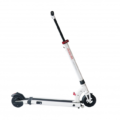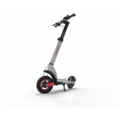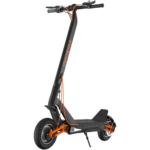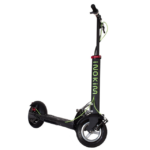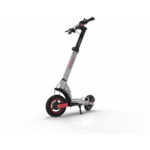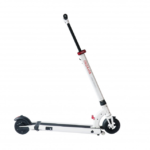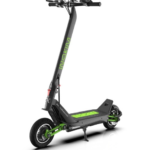- Home
- Scooters
- Electric Scooters
- INOKIM Light 2
INOKIM Light 2
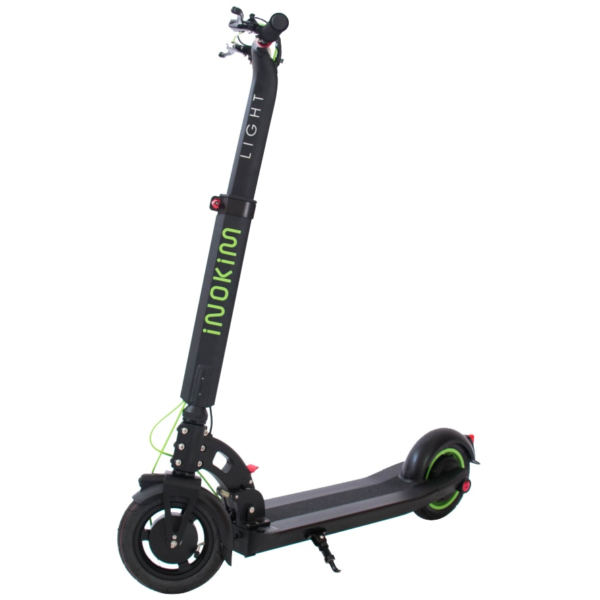

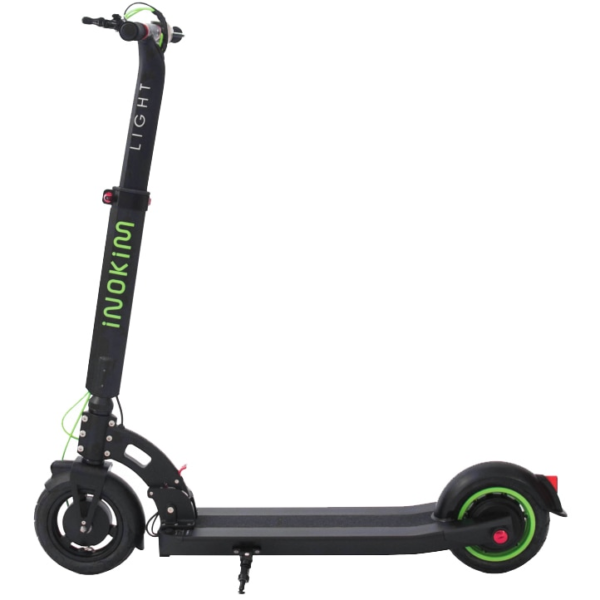
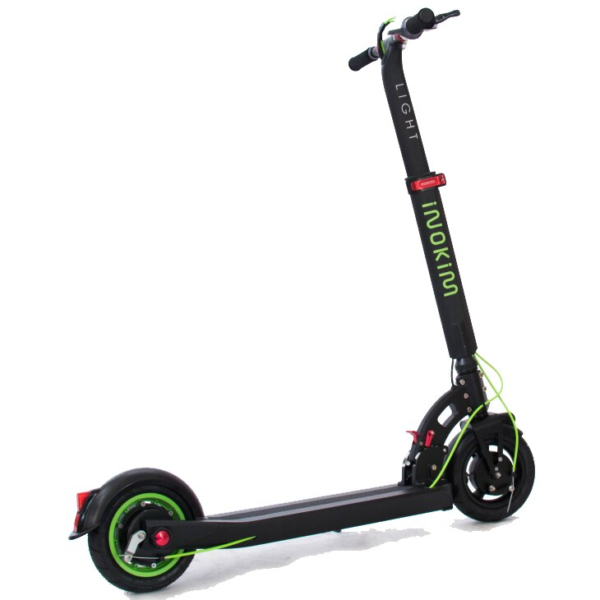
- Battery Range: 20–25 miles (32–40 km)
- Top Speed: 21 mph (34 km/h)
- Motor Power: 350 W
- Weight Capacity: 220 lb (100 kg)
- Charging Time: ~6–7 h
- Scooter Weight: 30.0 lb (13.6 kg)
PROS
- Light 30 lb (13.6 kg) foldable frame
- 8.5″ pneumatic tires
- Dual drum brakes front & rear
- Clear LCD with 3 riding modes
- Good build quality for commuting
CONS
- Limited range versus larger models
- No suspension
- IP rating not specified
- No Bluetooth app


Key Takeaways
- The INOKIM Light 2 is a lightweight, portable city scooter designed for daily commuting, featuring a solid build and easy folding mechanism.
- It includes a sealed rear hub motor, dual drum brakes, and a low deck for stability, making it user-friendly for various riders.
- The scooter boasts a range of 15-28 miles depending on conditions, with a top speed of around 21 mph, making it suitable for urban environments.
- The design emphasizes comfort, control, and safety, with features like a thumb throttle, cruise control, and built-in lights for visibility.
- Ideal for city riders and commuters, it’s less suitable for hilly routes or those seeking high-speed cruising.
Table of contents
- What Is the INOKIM Light 2?
- How the INOKIM Light 2 Works
- Key Specifications
- Design & Build Quality
- Performance Fundamentals
- Battery, Range & Efficiency
- Ride Quality & Comfort
- Braking & Safety Features
- Portability & Daily Usability
- Maintenance & Care
- Weather & Seasonal Considerations
- INOKIM Light 2 vs Alternatives
- Who the INOKIM Light 2 Is (and Isn’t) For
- FAQs
- Glossary
- Practical Setup Tips
- Real-World Riding Notes
- Troubleshooting Quick Guide
- Safety and Legal Basics
- Final Thoughts
The INOKIM Light 2 is a small, premium city scooter built for daily life. It’s light enough to carry, yet it feels solid on the road. It suits commuters, students, and multi-modal riders who want a quick fold and steady brakes. And it slips into tight spaces without drama.
What Is the INOKIM Light 2?
The INOKIM Light 2 is a lightweight, single-motor scooter with dual drum brakes and 8.5-inch tires. It sits in the portable commuter class and keeps things simple. The frame uses 6061-T6 aluminum, so weight stays low and flex stays in check. A rear hub motor pairs with a thumb throttle for smooth takeoffs. And the deck rides low, which helps you feel planted at normal city speeds.
The hinge is a compact block at the base of the stem. You flip a latch, pull a safety pin, and fold it in seconds. The folded package is flat and tidy, so it slides under a desk or beside your seat on a train. Fit and finish are clean, and cable runs are easy to service. So the scooter ends up feeling like a tool you can trust day after day.
How the INOKIM Light 2 Works
Power delivery is simple. A sealed, gearless rear hub motor drives the wheel. You press the thumb throttle, and the controller feeds power in a smooth ramp. The LCD shows speed, mode, and battery bars, so you keep the basics in view. And both brake levers pull on drum brakes that stay consistent in dry and wet conditions.
Think of the motor as a quiet “pancake” inside the wheel. There’s no chain and no belt, so you skip lube and tension jobs. The controller lives in the deck and tells the motor how hard to push. The battery sits low in the deck too, which keeps the center of gravity down. Then you charge with a simple brick, ride, and repeat. There’s not much to fuss over.
Key Specifications
Regional trims can vary a bit. Battery size, tire mix, and small fittings may differ by market. The core package stays the same.
| Category | Details |
|---|---|
| General | Model: INOKIM Light 2. Frame: 6061-T6 aluminum. Display: LCD with speed, modes, and battery level. Max load: 220 lb (100 kg). |
| Performance & Power | Motor: rear hub, 36 V, 350 W nominal (about 650 W peak). Top speed: up to ~21.7 mph (35 km/h) depending on region and mode. Hill use: best on short city grades with a run-up. |
| Battery, Charging & Electrical | Battery: 36 V lithium-ion, common sizes ~10.4–12.8 Ah (≈374–461 Wh). Claimed range: ~18.6–28 mi (30–45 km) in easy conditions. Charge time: ~3–5 hours. Lights: built-in front and rear LEDs. |
| Build & Dimensions | Tires: 8.5 in. Many trims ship two pneumatic tires; some pair an air front with a solid rear. Deck: ~18.3 × 7.0 in (46.4 × 17.8 cm). Weight: ~31 lb (≈14.1 kg). Folded size: ~42.5 × 7.0 × 14.2 in (108 × 17.8 × 36 cm). |
| Safety & Control | Brakes: dual drum with motor cut-off. Kick-to-start: yes. Side visibility: reflectors by market. Water resistance: IPX4. |
| Features & Extras | Thumb throttle, cruise control (toggle in display), safety-pin folding latch, kickstand, charge-port cap. |
| Warranty & Compliance | Typical warranty: 12 months on core parts (regional terms vary). Compliance: variants tested to UL 2272 in many markets. |
Design & Build Quality
The design goal is clear. Ride every day with little drama. The deck sits low, so starts and stops feel stable. The aluminum sections are thick where they need strength. Welds look neat, and panels fit flush. And the hinge locks with a confident click when it’s set up right.
The cockpit keeps controls close. The display sits near center, and the mode keys are easy to tap with a thumb. Lever reach fits a wide range of hands. Cable routing is tidy and external, so service stays simple. And the drum brakes hide inside the wheels, which keeps grit and spray away from the friction surfaces.
Paint holds up well to racks and doors. The deck grip is coarse, so shoes stay secure in rain. Plastics feel tight, and the scooter runs quiet on smooth pavement. You can lift it by the stem or the deck cutout. And the balance point sits near the middle, so stair carries feel natural.
Performance Fundamentals
Takeoffs feel smooth and measured. The throttle gives fine control at walking speed, so you can ease through crowds. Power builds in a clean curve, and the scooter settles at cruise without surge. The motor runs quiet, so tire noise becomes the main sound at speed.
Stability stays calm in the 12–18 mph (20–30 km/h) band. The low deck and 8.5-inch tires take the edge off small joints and cracks. The stem tracks straight if bolts are at spec. And steering feels predictable as you lean through turns. Keep your knees soft and your weight centered, and the scooter follows your line.
Hills show where this class sits. Short rises feel easy, and it holds speed with a touch more throttle. Long grades around 7–10% slow the pace, so a brief run-up helps. On very steep streets, plan an alternate path or step off and walk. That’s the trade for low carry weight.
Battery, Range & Efficiency
The pack runs at 36 V with common sizes between 10.4 Ah and 12.8 Ah. That adds up to roughly 374–461 Wh of energy. Light riders on flat routes can touch the high end of the claimed range. Heavier riders, cold days, hills, and headwinds trim distance. Hard launches and top-speed cruising pull more watts per mile too.
In mixed city use, plan for about 15–20 mi (24–32 km) on a full charge. You can stretch distance by riding at a steady pace, avoiding hard starts, and keeping tires at the right pressure. You can shrink it by sprinting between lights. So match speed to your route and your battery plan.
Charging is straightforward. Plug the brick into the wall first, then the scooter. A full cycle often takes three to five hours from low. Many riders top up at work to split the day. And lithium cells like partial charges, so you don’t need 100% every time. Store the scooter indoors, and keep it away from heat to help the pack last.
Ride Quality & Comfort
Comfort comes from tire choice, frame stiffness, and deck height. Many trims ship with two pneumatic 8.5-inch tires for grip and compliance. Some use a pneumatic front and a solid rear to cut flats. Air tires take the edge off cracks and joints. A solid rear blocks punctures but sends more buzz to your feet. So pick what fits your roads and how you feel about flats.
Ergonomics are friendly. The deck supports a wide stance. The bar height fits most adults, and the thumb throttle keeps your wrist neutral on long runs. Stem flex stays low when bolts are at spec. And the scooter tracks straight at cruise on clean pavement.
On rough patches, soften your knees and choose smooth lines. The wheelbase is compact, so timing matters. The scooter responds fast to small steering inputs. Grip stays stable on dry asphalt and predictable in light rain. In the wet, brake earlier and give yourself more room.
Braking & Safety Features
Dual drums deliver steady, low-service stops. The shoes sit sealed from grit and water, so lever feel changes little over time. Bite builds by mid-pull, and the scooter slows straight. And motor cut-off on brake pull helps you stop clean without power pushing forward.
Lights come built in. The front light helps others see you, and the rear light boosts visibility at dusk. For dark lanes, add a brighter bar-mounted headlight so you can see farther ahead. Side reflectors help cross-traffic pick you up at night. And the IPX4 rating covers splashes from any direction, not full soak.
Cruise control sits in the display menu. Hold a steady speed for a few seconds, and it locks in. Use it on open paths, not in mixed traffic. Kick-to-start helps prevent surprise launches at lights. Keep that setting on in busy areas.
Portability & Daily Usability
Portability is the point here. At about 31 lb (≈14.1 kg), short carries are easy. The fold takes seconds: flip the latch, pull the pin, and lower the stem. The folded shape is slim, so it slides under desks and into trunks. And the low deck makes doorway thresholds easier to roll over without a tap.
Daily habits pay off. Park indoors when you can. If you must lock outside, use a sturdy U-lock through the frame window and a fixed anchor. Take your charger and any removable bits with you. And set the scooter on the kickstand only on level ground.
Storage is simple. Keep it at room temperature and out of direct sun. If you’ll pause riding for a few weeks, store the pack near half charge. Then check tire pressure before your next ride. You’ll be set.
Maintenance & Care
A short routine keeps the scooter tight and quiet.
Before each ride
- Check tire pressure. Many 8.5-inch tube tires ride well near 50–55 psi. Adjust for weight and comfort.
- Squeeze both levers. You should feel firm bite by halfway through the pull.
- Inspect the hinge latch and safety pin. Both must seat fully.
Every two weeks
- Check stem clamp, lever clamps, and wheel nuts. Tighten to spec.
- Wipe the deck and stem with a dry or lightly damp cloth. Keep the charge-port cap clean and closed.
- Inspect tire sidewalls, valve stems, and tread wear.
Every two to three months
- Tune brake feel with the lever barrel adjusters if the bite point drifts.
- Inspect cable housings for kinks or rub points.
- Check the hinge for play. If you feel movement, adjust per the manual and test.
Flat prevention and repair
- Keep pressure in range. Low pressure invites pinch flats.
- If your streets have debris, consider puncture strips or tougher tubes up front.
- If your unit runs a solid rear, you dodge rear flats and accept more buzz. If both are pneumatic, keep a spare tube and tire levers at home, and fix flats where you have space.
Battery care
- Keep daily cycles between roughly 20% and 90% when you can.
- Let a very hot or cold pack rest to room temperature before charging.
- Use the correct charger and a grounded outlet.
Weather & Seasonal Considerations
Light rain rides are doable with care. IPX4 covers splashes, not heavy rain or puddles. So slow down on paint lines and metal plates. Brake earlier, and leave extra space. Then dry the scooter after the ride and leave it open so moisture can evaporate.
Heat shortens cell life. On hot days, park in the shade and charge indoors. Cold cuts range, so expect fewer miles in winter. Tire pressure drops with temperature, so check it more often. Road salt can corrode parts in winter. Wipe the deck and wheels after salted rides, and keep fasteners clean and dry.
Wind matters too. Headwinds raise energy use and cut range. Tailwinds help a bit. So plan loops with margin. In gusts, lower your stance, bend your knees, and relax your arms. The scooter has a small frontal area, and your posture helps even more.
INOKIM Light 2 vs Alternatives
The Light 2 shines when you want strong brakes, a solid fold, and low weight. Some ultra-light rivals weigh less but give up braking power or deck space. Some add basic suspension but bring bulk and rattles. A few match range yet use belts or chains that need more care. If you prefer a classic city runabout with a sit-up stance, the MotoTec Metro points in a different styling and ergonomics direction.
Mid-weight commuters run bigger batteries and 500–800 W motors. They hold higher speeds and climb longer hills, so they fit longer routes. They weigh more and feel bulky on stairs and trains. The Light 2 trades some hill pace for a smaller footprint and easier carries. On the compact value side, the iScooter F2 targets riders who want a straightforward setup and simple daily use.
High-performance scooters bring dual motors, hydraulic brakes, and huge packs. They rocket up hills and stay fast at speed. They weigh much more, take more space, and ask more upkeep. For many riders, those gains are not worth the mass. The Light 2 hits a sweet spot for short to medium trips, steady stops, and quick folds.
Who the INOKIM Light 2 Is (and Isn’t) For
Great fits
- Multi-modal commuters who fold, carry, and ride every day.
- Students and office workers with indoor storage.
- New riders who want smooth throttle control and calm manners.
- City riders who value sealed brakes and simple service.
Poor fits
- Very hilly routes with long, sustained climbs.
- Riders who want 30+ mph cruise or extreme range.
- Unpaved paths with deep cracks or loose gravel.
- Riders who prefer suspension comfort more than compact size.
Match the scooter to your route. If your trips are flat to rolling and short to medium, this model will feel right. If you need big hill pace or long, fast runs, a larger class will serve you better.
FAQs
How fast does the INOKIM Light 2 go?
It reaches about 21–22 mph (≈35 km/h) on many trims. Some regions ship lower limits, and you can set a cap in the display within local rules.
How far can it travel on one charge?
In easy conditions, plan for about 18.6–28 miles (30–45 km). In mixed city use, expect roughly 15–20 miles (24–32 km). Rider weight, speed, and weather swing results.
Does it have cruise control?
Yes. You can enable it in the display. Hold a steady speed, and it locks in. Use it on open paths, not in traffic.
What tires does it use?
Many trims ship with two 8.5-inch pneumatic tires. Some pair an air front with a solid rear. Air adds comfort and grip. A solid rear cuts flats at the cost of more buzz.
What tire pressure should I run?
A common range is 50–55 psi for tube tires of this size. Set pressure for your weight and comfort. Check often, since small tires lose air faster.
What water rating does it carry?
IPX4. That means splash resistance from any direction. Avoid heavy rain, standing water, and power washing.
Where can I find an INOKIM Light 2 overview?
You’re reading an INOKIM Light 2 overview that covers design, power, range, ride feel, safety, and care.
Glossary
Ah (amp-hours)
Battery capacity. Higher Ah means more charge stored.
Wh (watt-hours)
Battery energy. Volts × amp-hours = watt-hours.
Controller
Electronics that meter power from the battery to the motor.
Thumb throttle
A small lever you press with your thumb to command power.
Kick-to-start
A safety mode that needs a short push before the throttle engages.
Drum brake
A sealed brake inside the wheel hub. It offers steady, low-service stops.
Regen
Electronic braking that sends power back to the pack. This scooter relies on drums for most stopping.
Stem flex
Bend you can feel in the steering tube under load. Less flex feels more stable.
IP rating
Ingress Protection rating for dust and water. IPX4 covers splashes, not immersion.
PSI
Pounds per square inch. The unit for tire pressure.
Peak power
Short burst output. It’s higher than continuous power.
UL 2272
A safety standard for electrical systems in personal e-mobility devices.
Folded dimensions
Size when folded. This helps you judge storage and carry fit.
Hub motor
A motor built into the wheel that needs little maintenance.
Deck
The platform you stand on. Size and grip affect comfort and control.
Practical Setup Tips
Dial in the cockpit
Set lever angles so your wrists stay straight. Tighten clamp bolts evenly. Leave the small gap where the clamp design calls for it.
Set the display
Pick a speed cap that fits local rules. Turn on kick-to-start for crowded areas. Then try cruise control on open paths once you know your route.
Protect the hinge
Keep latch faces clean. Close the latch with a firm push, insert the pin, and tug the stem to confirm lock. Recheck after the first few rides.
Carry kit
Keep a pump with a gauge at home. Add a spare tube, levers, and a small hex set. Then small fixes stay small.
Real-World Riding Notes
Starts
Give a short push, then press the throttle. The scooter rolls out smooth and steady. New riders will like the gentle ramp.
Cruise
Hold a calm pace and keep knees soft. The platform feels planted, and the bar stays quiet. Long bike-lane runs feel easy.
Stops
Squeeze both levers and shift weight rearward. Bite builds by mid-pull, and the scooter slows straight. The motor cut keeps the stop clean.
Turns
Look where you want to go and lean with the scooter. The compact wheelbase responds fast to small inputs. Keep your arms relaxed and your eyes up.
Troubleshooting Quick Guide
Scooter will not power on
Check the battery level and deck power switch. Then reseat the display cable and close the charge-port cap.
Throttle unresponsive
Confirm kick-to-start is on. Push to walking speed and press the throttle. If that fails, check for a loose display connector.
Brake rub
Lift the wheel and spin it. Light rub often self-centers after a short ride. If it stays, tweak cable tension with the lever adjuster.
Stem play
Open the latch, clean the faces, and close it again. If play remains, adjust the hinge shim per the manual and test.
Short range
Check tire pressure and slow your cruising speed a bit. Cold weather and headwinds reduce distance, so plan an extra margin in winter.
Safety and Legal Basics
Local rules differ by city. Speed caps and permitted lanes vary. So set your top speed to match local limits. Wear a helmet on every ride. Use lights day and night in busy streets. Signal with your arms before turns. Ride with steady, predictable lines around people, and give space.
Final Thoughts
The INOKIM Light 2 focuses on needs that matter in a city scooter. It’s easy to carry, calm to steer, and simple to own. The brakes are steady, the fold is quick, and the controls are clear. And the motor and battery match urban speed and distance. Keep the tires in range, keep the hinge tight, and it will carry you through the week with little effort.
Specifications
General
| Model The Model specifies the exact version or name of the scooter. It helps identify its unique design, features, and specifications within the manufacturer’s product line. Knowing the model makes it easier to compare options, find compatible accessories, or look up support information. | Light 2 |
| Brand The Brand identifies the manufacturer or company that designs and produces the scooter. A trusted brand is a sign of quality, reliability, and good customer support. Well-known brands often have higher standards for safety, performance, and after-sales service, giving you more confidence in your purchase. | INOKIM |
| Release Date The Release Date indicates when the scooter model was officially launched on the market. This helps you know how current the design, technology, and features are. A newer release date often means updated components, improved performance, and the latest safety or smart features. | 18 November 2025 |
| Recommended Age Recommended Age indicates the minimum age range that the scooter is designed for, based on safety, size, and ease of use. Following the recommended age helps ensure that riders can handle the scooter’s speed, weight, and controls comfortably and safely. Always check local laws and use protective gear, especially for younger riders. | +16 |
Performance & Power
| Motor Power (Wattage) What it means: The motor power, measured in watts (W), shows how strong the scooter’s electric motor is. Why it matters: Higher wattage usually means better acceleration, more torque, and improved performance on hills or rough terrain. For example, a 250W motor is good for flat city roads and light riders, while a 500W or 1000W motor provides more power for faster speeds or climbing steep inclines. | 350 W rear hub motor |
| Top Speed The Top Speed indicates the maximum speed that the scooter can reach under optimal conditions. It’s usually measured on level ground with a fully charged battery and an average rider weight. A higher top speed allows you to travel longer distances faster, but always ensure you ride within legal speed limits and your personal comfort zone for safety. | 21 mph (34 km/h); may be limited to 25 km/h in some regions |
| Battery Capacity Battery Capacity refers to the total amount of energy the scooter’s battery can store, usually measured in ampere-hours (Ah) or watt-hours (Wh). A higher battery capacity means you can ride longer distances on a single charge, reducing the need for frequent recharging. Keep in mind that actual range can vary depending on rider weight, terrain, speed, and weather conditions. | 36 V 10.4 Ah (374 Wh) |
| Estimated Range per Charge The Estimated Range per Charge indicates the average distance the scooter can travel on a single full battery charge. This range is calculated under optimal conditions, such as flat terrain, moderate speed, and average rider weight. Real-world range may vary depending on riding style, terrain, weather, and load. A longer range means fewer recharges and greater freedom for longer trips. | 20–25 miles (32–40 km) |
| Hill Climb Ability Hill Climb Ability describes the maximum incline or slope that the scooter can handle while maintaining stable performance. It’s typically expressed as a percentage or in degrees. A higher hill climb rating means the scooter can tackle steeper hills without losing too much speed or power. Actual climbing performance may vary based on rider weight, battery charge, and terrain conditions. | Not specified |
| Drive System The Drive System refers to how power from the motor is delivered to the wheels. Electric scooters typically use either a hub motor (directly integrated into the wheel) or a chain/belt drive system. A high-quality drive system ensures smooth acceleration, efficient power transfer, and low maintenance. The choice of drive system affects performance, noise level, and overall ride experience. | Rear hub (RWD) |
Charging & Electrical
| Charging Time Charging Time indicates how long it takes to fully recharge the scooter’s battery from empty to 100% using the standard charger provided. Faster charging means less downtime and more time on the road. Actual charging time may vary slightly depending on battery capacity, charger output, and environmental conditions. | Approx. 6–7 hours |
| Battery Type Battery Type refers to the specific technology used in the scooter’s battery, which affects performance, lifespan, weight, and charging time. Most modern electric scooters use high-quality lithium-ion (Li-ion) batteries because they offer a good balance of energy density, durability, and low maintenance. A reliable battery type ensures consistent power delivery and longer riding ranges. | Lithium-ion pack |
| Removable Battery A Removable Battery means the battery pack can be easily detached from the scooter for convenient charging and replacement. This feature allows you to charge the battery separately, swap it with a spare for extended range, or securely store it indoors in extreme weather. Removable batteries add flexibility and make it easier to keep your scooter powered up wherever you are. | Non-removable internal battery (fixed pack) |
| Regenerative Braking Regenerative Braking is an energy-saving feature that converts some of the energy normally lost during braking back into battery power. When you slow down or brake, the motor works in reverse to generate electricity, which helps extend the scooter’s range and improves overall efficiency. This system also reduces wear on traditional brake components, leading to lower maintenance over time. | No |
| Lighting Lighting refers to the built-in front and rear lights that enhance visibility and safety when riding in low-light conditions or at night. Good lighting helps you see the road ahead and ensures that other road users can see you. Many scooters include LED headlights, taillights, and sometimes brake lights or side reflectors for added safety and compliance with local traffic regulations. | LED headlight + rear LED/brake + reflectors |
Build & Dimensions
| Scooter Weight Scooter Weight refers to the total weight of the scooter when fully assembled, including the battery. This affects how easy it is to carry, lift, and store the scooter when not in use. A lighter scooter is more portable and convenient for commuting, especially if you need to carry it upstairs or onto public transport. Keep in mind that a sturdy frame and quality components may add to the weight but also contribute to better durability and ride stability. | 30.0 lb (13.6 kg) |
| Maximum Rider Weight Maximum Rider Weight indicates the highest rider weight that the scooter is designed to safely support while maintaining optimal performance and stability. Staying within this limit helps ensure reliable acceleration, braking, and climbing ability, and it protects the frame, suspension, and motor from excessive strain. Exceeding the recommended limit may reduce performance and increase wear on components. | 220 lb (100 kg) |
| Deck Size Deck Size refers to the dimensions of the scooter’s standing platform. A wider and longer deck provides more foot space, allowing you to stand comfortably and adjust your stance while riding. A well-sized deck improves balance and stability, especially on longer rides or at higher speeds. Compact decks, on the other hand, help keep the scooter lightweight and portable. | Low deck; compact commuter geometry |
| Handlebar Height Handlebar Height refers to the distance from the deck to the handlebars, which affects your riding posture and comfort. An appropriate handlebar height helps you maintain good balance, reduces strain on your back and arms, and makes steering more comfortable. Some scooters have adjustable handlebars to fit riders of different heights, while others have a fixed height for a streamlined design. | Fixed |
| Folding Mechanism The Folding Mechanism describes how easily and securely the scooter can be folded for carrying and storage. A well-designed folding system lets you quickly collapse the scooter into a compact size, making it convenient to transport on public transit, store under a desk, or fit into a car trunk. Look for sturdy latches and safety locks to ensure the scooter stays firmly in place when folded or unfolded. | Quick-fold latch |
| Dimensions Folded Dimensions indicate the size of the scooter when it’s fully folded. This measurement shows how much space the scooter will take up when stored or carried, making it easier to check if it will fit in your car trunk, under a desk, or in a closet. Compact folded dimensions are ideal for commuters who need to bring their scooter on public transport or store it in tight spaces. | Folded: Not specified; Unfolded: Not specified |
| Material Material refers to the primary construction materials used for the scooter’s frame and key components. High-quality materials like aircraft-grade aluminum, reinforced steel, or durable composites provide strength, stability, and a lighter overall weight. A sturdy material ensures the scooter can handle daily wear and tear while maintaining safety and performance. | Aluminum alloy |
Safety & Control
| Brake Type(s) Brake Type(s) describe the braking systems the scooter uses to help you slow down or stop safely. Common brake types include mechanical brakes (like drum or disc brakes), electronic brakes, and foot brakes. Many scooters combine multiple braking systems for added safety and shorter stopping distances. The type and quality of brakes affect your control, especially when riding at higher speeds or on slopes. | Dual drum brakes (front & rear) |
| Suspension Suspension refers to the system that absorbs shocks and vibrations while riding, providing a smoother and more comfortable ride over uneven or rough surfaces. Scooters may have front suspension, rear suspension, or dual suspension for better shock absorption and stability. Good suspension helps reduce rider fatigue and improves control, especially when riding on bumpy roads or off-road paths. | None |
| Tire Type Tire Type refers to the kind of tires the scooter uses, which directly affects ride comfort, traction, and maintenance. Common types include solid (airless) tires, pneumatic (air-filled) tires, or hybrid options. Pneumatic tires offer better shock absorption and a smoother ride on rough surfaces, while solid tires are puncture-proof and require less upkeep. The right tire type helps ensure safe handling and a comfortable ride in different conditions. | 8.5″ pneumatic tires |
| Tire Size Tire Size indicates the diameter and width of the scooter’s tires, which affect ride comfort, stability, and how well the scooter handles different terrains. Larger tires generally offer better shock absorption and a smoother ride over bumps and rough surfaces, while smaller tires keep the scooter lighter and more portable. Choosing the right tire size helps ensure a balance between agility and comfort. | 8.5-inch |
| Kickstand The Kickstand is a built-in stand that allows you to park your scooter upright when it’s not in use. A sturdy kickstand keeps the scooter stable and prevents it from tipping over, protecting it from scratches and damage. It also makes storing and accessing your scooter more convenient, whether you’re at home, work, or on the go. | Side kickstand |
| Water Resistance Rating Water Resistance Rating indicates how well the scooter is protected against water and moisture, usually shown as an IP (Ingress Protection) rating. This rating helps you understand whether the scooter can handle light rain, splashes, or wet roads without damage. While most scooters are not fully waterproof, a good water resistance rating adds peace of mind when riding in changing weather conditions. Always avoid deep puddles or submerging the scooter to protect its electrical components. | Not specified |
Features & Extras
| Display/Console The Display (or Console) shows important real-time information about your ride, helping you monitor your scooter’s status at a glance. Typical displays show speed, battery level, distance traveled, and riding mode. Some models also include additional features like Bluetooth connectivity, app integration, or backlighting for better visibility at night. A clear and easy-to-read display enhances safety and convenience on every trip. | LCD display with speed, battery, trip |
| Ride Modes Ride Modes refer to the different speed and power settings you can choose to match your riding style or road conditions. Common modes include eco for maximum range and energy efficiency, standard for everyday balance, and sport or turbo for higher speed and stronger acceleration. Switching between ride modes allows you to customize performance, conserve battery, and ride safely in various environments. | Eco/Drive/Sport (3 modes) |
| Smart App Connectivity Smart App Connectivity lets you pair your scooter with a dedicated mobile app via Bluetooth. Using the app, you can monitor real-time ride stats like speed, battery level, and range, adjust settings such as ride modes or cruise control, lock the scooter for added security, and sometimes receive firmware updates. This feature adds convenience and allows you to personalize your riding experience right from your smartphone. | None |
| Anti-Theft System The Anti-Theft System helps protect your scooter from unauthorized use or theft. This feature can include built-in alarms, electronic motor locks, GPS tracking, or remote locking through a mobile app. A good anti-theft system provides peace of mind when parking your scooter in public spaces, adding an extra layer of security to safeguard your investment. | None noted |
| Cruise Control Cruise Control allows you to maintain a steady speed without continuously holding the throttle. This feature makes longer rides more comfortable by reducing hand fatigue and providing a smoother, more relaxed riding experience — especially on flat, open roads or bike lanes. For safety, cruise control can usually be easily activated or deactivated while riding. | Yes (cruise control) |
| Accessories Included Accessories Included lists the additional items that come with the scooter to enhance your riding experience and convenience. Common accessories may include a charger, kickstand, bell, lights, phone holder, or carrying strap. These extras add value by making your scooter safer, easier to use, and ready to ride straight out of the box. | Scooter, charger, tools, manual |
Warranty & Compliance
| Warranty Period The Warranty Period indicates how long the manufacturer guarantees the scooter against defects in materials and workmanship under normal use. A good warranty provides peace of mind, showing the brand’s confidence in its product quality. Always check what parts are covered, such as the frame, battery, and motor, and follow the maintenance guidelines to keep your warranty valid. | 12 months (region-dependent) |
| Certifications Certifications confirm that the scooter meets specific safety, quality, and environmental standards set by recognized organizations or regulatory bodies. Common certifications may include CE, RoHS, UL, or other local compliance marks, depending on your region. These certifications ensure that the scooter is manufactured to high standards and is safe and legal to use in your country. | Local micromobility compliance |
Price Comparison




